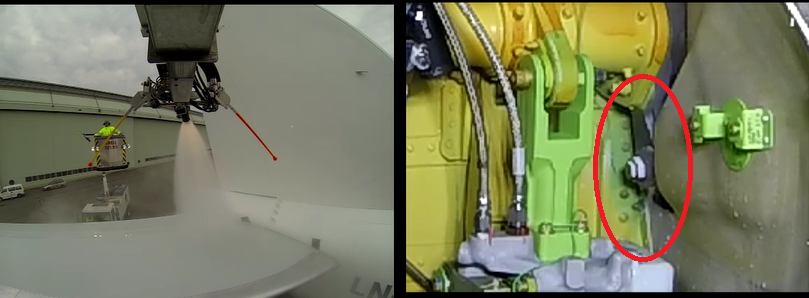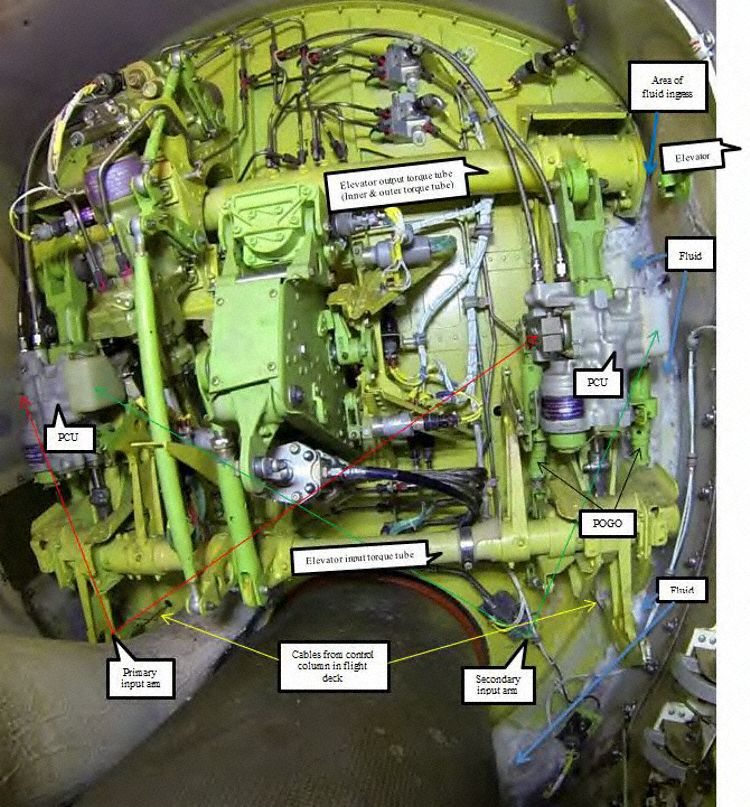De-Iced Drama : 737 in Scandinavia
During the approach to the Finnish airport of Kittilä on 26 December 2012, Norwegian Air Shuttle‘s Boeing 737-800 LN-DYM came close to stalling as a result of a blocked elevator. The elevator system worked at only 1/250th of the expected effectiveness according to investigators.
The Investigation
The Accident Investigation Board Norway (AIBN – the Statens Havarikommisjon for Transport [SHT] in Norwegian) released their investigation report and three safety recommendation in March 2015. De-icing, with 3000l of fluid (unthickened Type I fluid) had been carried out prior to departure from Helsinki to remove about 25 cm of snow that had settled on the aircraft since it had last flown on 23 December 2012. The AIBN report that:
As the aircraft was in the process of intercepting the glide slope, the elevator trim started to pitch the nose up. This trim continued for 12 seconds. At the same time, the aircraft started to unintentionally ascend while the autothrottle commanded full engine thrust. Both pilots eventually pushed the elevator control column with full force, but the aircraft’s nose continued to pitch up to an angle of +38.5° before slowly decreasing. The aircraft’s speed dropped to 118 kt (Calibrated Airspeed, CAS) and the Angle of Attack (AOA) reached a maximum of approximately 25°. The aircraft was thus close to stalling. The aircraft’s autopilot was disengaged just after the aircraft’s nose angle was at its highest. Control over the aircraft was slowly regained. A new approach was carried out without additional problems.
The AIBN classified this occurrence as a Serious Incident noting:
The aircraft was relatively low above the terrain and in clouds, and it would have been difficult for the pilots to regain control of the aircraft with an elevator system that did not function as intended.
AIBN’s investigation determined that:
…even after the introduction of new de-icing procedures from Boeing, considerable volumes of fluid and pertaining humidity are penetrating the Tail Cone Compartment during de-icing of the Boeing 737 aircraft type. The investigation shows fluid penetration toward the four Input cranks on the aircraft’s two Power Control Units. If this fluid freezes in the narrow gap between the Input cranks, this may result in blockage of the Power Control Units. This prevents operation of the elevator on Boeing 737 with potentially catastrophic outcome.
The AIBN report features dramatic video of fluid pouring into the Tail Cone Compartment during trial de-icing of those revised procedures.
AIBN also discuss Scandinavian experience with higher than normal elevator control loads and a case of Foreign Object Debris (FOD) that jammed a Power Control Unit (PCU) on a Turkish B737-400 in 2009.
Safety Recommendations
The AIBN have issued Recommendation SL 2015/01T to Boeing, /02T to the FAA and /03T to EASA. The last two relate to FAA and EASA ensuring Boeing conduct SL 2015/01T, namely:
AIBN recommends that the aircraft manufacturer Boeing conduct a new safety assessment of the Boeing 737 aircraft type as regards blockage of the aircraft type’s elevator system, and establish measures in order to satisfy the requirements in FAR Part 25 § 25.671 and EASA CS-25 §25.671.
Reporting and Assessment of Incidents
The Commander did not make any entry in the Technical Log regarding the abnormality experience with the flying controls. The Commander said to AIBN that he had a telephone conversation with the airline’s Maintenance Control Center (MCC) at Gardermoen and that after debate it was decided that the aircraft could continue flying. Two days later, the Commander contacted the on-call chief pilot. The on-call chief pilot also did not perceive the incident to be serious. Consequently, the CVR data was not preserved, although FDR data was available. This perception has occurred before in similar cases such as that of a B737-300 at Bournemouth Airport in the UK on 23 September 2007 which suffered excessive pitch during a go-around. In that case:
Although the commander reported the event to the operator the following morning, his initial Air Safety Report (ASR) contained limited information and the seriousness of the event was not appreciated until the Quick Access Recorder (QAR) data was inspected on 4 October 2007.
AIBN state that the operator’s MCC:
… did not register any inquiries in its data log after the Kittilä incident, and technical personnel on duty on the day in question have explained to AIBN that they cannot remember the inquiry from the commander. …the company has conveyed that they have implemented measures and that starting from now on all calls to MOC and to Operations Control Center (OCC) are recorded.
There have been other occurrences where recollection of telephone calls have been of critical interest in the subsequent investigation, such as the loss of AS332L2 G-REDL and 16 lives on 1 April 2009 (UK AAIB report and Fatal Accident Injury), where a recording of a discussion regarding a maintenance finding a week earlier would have eliminated ambiguities in recall, as would have written records.
Training
AIBN did not identify any need to change the operator’s operational procedures but AIBN comment that “training and system understanding must receive additional focus”, though they have made no formal safety recommendations in this area. They state:
AIBN is of the opinion that Norwegian has a training concept which seems to be well-founded. The company’s account of its philosophy, plans and implementation appears to be well thought-through. AIBN would like to commend the company for exceeding the authorities’ minimum requirements as regards theoretical instruction, simulator training, and training in connection with various sectors for commercial flights. In spite of this, the flight crew did not seem to have sufficient system understanding and automatic reflex to handle the incident in an optimum manner. AIBN considers that the aviation industry must focus continually on this aspect given the increasing automation in the cockpit.
Automation has been the subject of several past Aerossurance articles including: Technology Friend or Foe The ‘Automation Problem’ – A Discussion
UPDATE 8 August 2017: FAA issue an SAIB on this accident:
Procedural changes have been made to the 737 Flight Crew Operations Manual (FCOM) D6-27370-TBC, dated September 25, 2014, and the Boeing 737-600/700/800/900 Aircraft Maintenance Manual (AMM), Task 12-33-01 “Cold Weather Maintenance Procedure,” dated October 15, 2014, to reduce the amount of fluid that can enter the tail cone through the elevator linkage side cutout. The revised FCOM procedure instructs the flight crew to position the horizontal stabilizer at the calculated take-off setting within the green band range for de-icing. The revised AMM procedure instructs maintenance personnel to position the horizontal stabilizer to five units of trim. Additional guidance for these procedures can be found in Boeing Fleet Team Digest 737NG-FTD-27-13005.
Other Resources
Icing conditions (ground and in flight) was the topic for a European Aviation Safety Agency (EASA) conference in 2013.
Aerossurance has also published other icing articles:
- Canadian Mining Air Accident (Cessna 208B Caravan): where a cold soaked aircraft took off over gross weight due to accumulated ice from a previous flight.
- Breaking the Chain: X-31 Lessons Learned: where an experimental NASA aircraft was lost after pitot tube icing.
- UPDATE 8 June 2015: Cessna Citation Excel Controls Freeze
- UPDATE 2 November 2015: ATP Serious Incident – Temporary LOC In Icing Conditions
- UPDATE 3 December 2016: ATR72 Control Problems in Severe Icing, Norway, 14 November 2016
For expert support you can trust on flight safety, safety investigation and safety management, contact Aerossurance: enquiries@aerossurance.com
Follow us on LinkedIn and on Twitter @Aerossurance for our latest updates.



Recent Comments